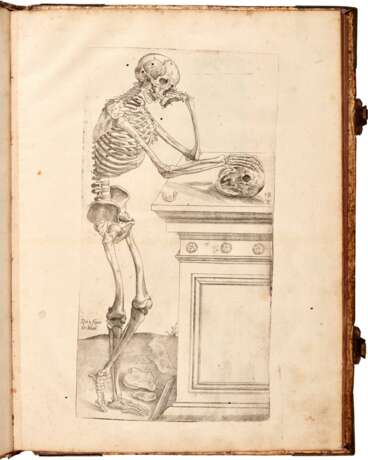Andreas Vesalius and Jacob Bauman | Anatomia Deudsch. Ein kurtzer Ausszug, der Beschreibung aller glider menschlichs Leybs, Nuremberg, 1551
28.11.2023 14:00UTC +00:00
Classic
Verkauft
30480GBP £ 30 480
| Auctioneer | Sotheby´s |
|---|---|
| Veranstaltungsort | Vereinigtes Königreich, London |
Archiv
Die Auktion ist abgeschlossen. Es können keine Gebote mehr abgegeben werden.

ID 1076608
Los 85 | Andreas Vesalius and Jacob Bauman | Anatomia Deudsch. Ein kurtzer Ausszug, der Beschreibung aller glider menschlichs Leybs, Nuremberg, 1551
Schätzwert
£ 30 000 – 50 000
Anatomia Deudsch. Ein kurtzer Ausszug, der Beschreibung aller glider menschlichs Leybs. Nuremberg: Julius Paulus Fabricius, 1551
FIRST EDITION IN GERMAN, folio (423 x 300mm.), title with the arms of the city of Nuremberg, 40 FINE ENGRAVED ANATOMICAL PLATES, fine contemporary blind-stamped pigskin over bevelled wooden boards, the book’s title stamped on upper cover, dated “1586”, original brass cornerpieces and clasps, title with narrow section cut away at lower edge (to remove previous owner’s name?), dedication leaf with small blank portion at lower corner renewed, small wormholes throughout, binding with some small wormholes
An attractive copy in contemporary pigskin of the first edition of the rare German digest of Vesalius’ Fabrica and Epitome, and just the second appearance in any vernacular language of a watershed work in the history of medicine. It is notable as the first printing of Vesalius with engraved, rather than woodcut, illustrations.
Although Vesalius is acknowledged in the introduction, this is essentially a pirated edition—the first of dozens to appear across Europe—put out by the Nuremberg physician Jacob Baumann (1521-1586), with copies of the anatomical plates from Thomas Geminus’ Compendiosa totius anatomiae delineatio (London, 1545).
Born in Brussels, Andreas Vesalius (1514-64) received his medical education in Louvain and Paris. He moved to Padua, where he began teaching anatomy, and eventually became physician to the German emperor Charles V and his son Philip II. Vesalius’ revolutionary findings challenged older medical teaching derived from Galen, whose anatomy had been based on the dissection only of animals. In Padua, Vesalius developed his new observations through human dissection, working on the bodies of executed criminals. His De humani corporis fabrica libri septem was first published in Latin in 1543 in Basel, illustrated with its famous naturalistic woodcut figures, made under the author’s close supervision.
The now extremely rare Epitome, an abridged version designed as a teaching aid, appeared the same year, also in Basel. The large woodcut figures were re-cut, on a slightly larger scale, and two new figures of a male and a female nude (Adam and Eve) were added. Published in the same place and year, a German translation of the “Epitome”— with the same woodcut illustrations—was prepared by Alban Thorer. As pointed out by Cockx-Indestege in her census, and by Cushing in his “Bio-Bibliography” of Vesalius, the present edition “is something of a curiosity since it is printed on single, unfolded sheets with adjacent pages of the gatherings pasted together so as to facilitate assemblage.” (Cushing, p. 132) The coat of arms on the upper cover features a man (the “wild man” or “green man”) clutching two plants in either hand, above an escutcheon. At one time this was painted, and it still retains some of the original colour, as does the gilt wreath surrounding the image, which was painted green.
| Künstler: | Andreas Vesalius (1514 - 1564) |
|---|---|
| Kategorie des Auktionshauses: | Drucke, Graphik, Bücher |
| Künstler: | Andreas Vesalius (1514 - 1564) |
|---|---|
| Kategorie des Auktionshauses: | Drucke, Graphik, Bücher |
| Adresse der Versteigerung |
Sotheby´s 34-35 New Bond Street W1A 2AA London Vereinigtes Königreich | |
|---|---|---|
| Vorschau |
| |
| Telefon | +44 (0) 20 7293 5000 | |
| Telefon | +1 212 606 7000 | |
| Nutzungsbedingungen | Nutzungsbedingungen |





